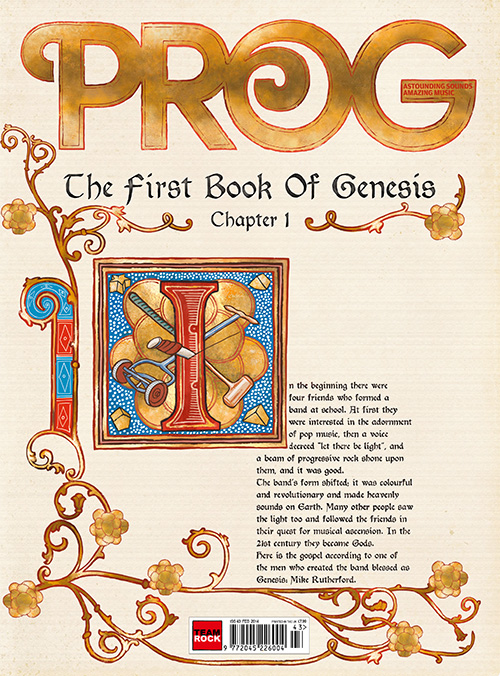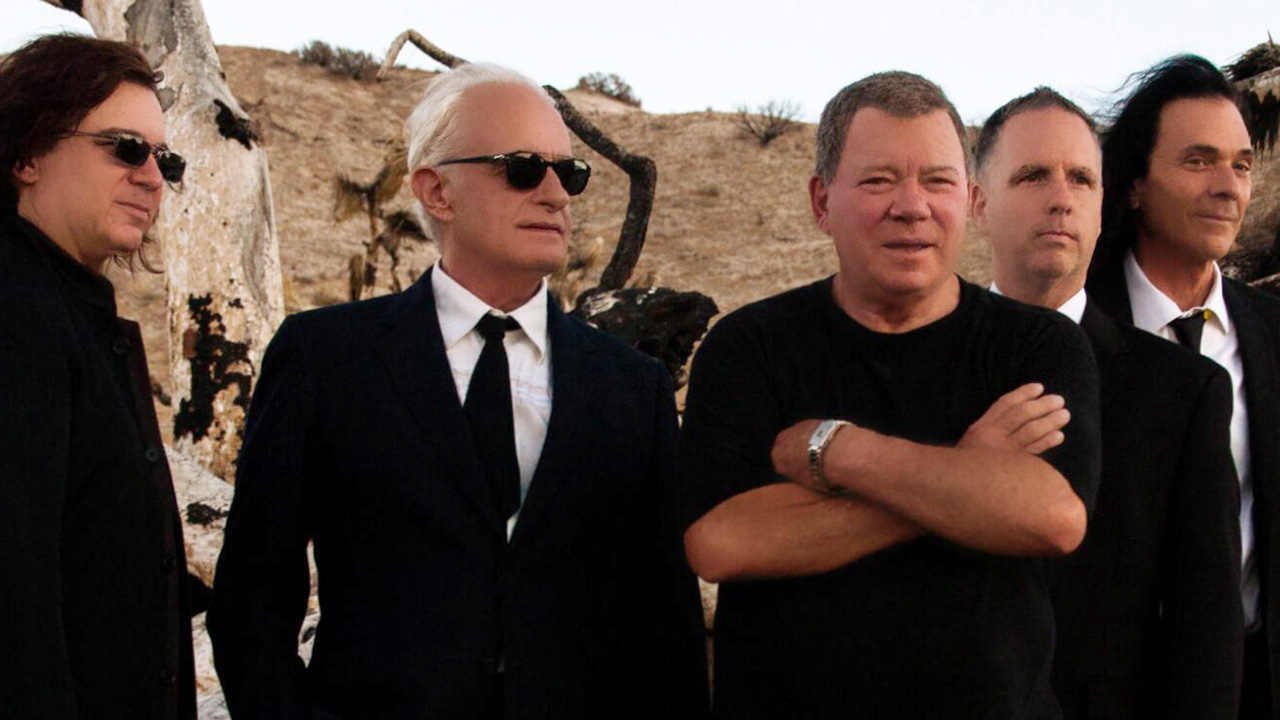Star Trek hero William Shatner had never listened to prog before he started work on 2013 album Ponder The Mystery (which he revisited a decade later). Inspired by Billy Sherwood (before his full-time return to Yes) the pair created an album dripping with heavyweight guest talent. It led to the actor’s discovery of a connection between progressive music and science fiction, and a record that moved him to tears.
“Every year Tom Hanks has a Shakespeare reading to raise funds for schools,” says William Shatner, demonstrating his ability to spin a great celebrity yarn. “He gets all his friends together – of which I’d like to consider myself one – and we do a reading of one of Shakespeare’s plays. The latest one is The Two Gentlemen Of Verona. Paul McCartney is going to sing some songs, and I’m going to do Lucy In The Sky With Diamonds with him.”
That $1,500-per-seat event took place at a sold-out Broad Stage Theater in Santa Monica. Hanks, Macca and Shatner were joined by Val Kilmer and Seinfeld’s Jason Alexander, among others, to raise money for various good causes.
With its tempo changes, Mellotron intro and marshmallow skies, Lucy is a pretty proggy piece of work. Shatner’s remarkable take on it was the highlight of The Transformed Man, his debut album – released in 1968 as the original Star Trek series was entering its third and final season. “My understanding is Paul found my interpretation ‘interesting!’” the actor laughs. “That’s the word he used!”
William Shatner does. From time to time. Speak in. Staccato bursts. Also, he has a knowing, almost English sense of irony about himself. He’s well aware that many people might find him – or at least his musical endeavours – faintly absurd. And yet he’s friendly, articulate and, with his 83rd birthday coming up, still in possession of more marbles than many Hollywood stars begin with.
“He’s just an amazing, down-to-earth guy and an amazing artist,” says former Yes guitarist Billy Sherwood. “He’s capable of going to the Bahamas and retiring, but he wants to continue with his art, and I respect that.”
Sherwood has collaborated with Shatner on his fourth musical enterprise, Ponder The Mystery. They were introduced by Brian Perera, founder of Sherwood’s regular label Cleopatra, which also released Shatner’s daffy 2011 covers album Seeking Major Tom.
“Brian suggested I meet Billy,” says the actor, “and they asked what I’d do. I said, ‘Well, I could take a period of time: there’s a guy on a beach who’s in despair an hour before sunset. The sun sets, and through the beauty of what he sees, he regains his joy of life.’
”They said, ‘Uh, okay!’ They didn’t really know what I was talking about – and in a way, neither did I. I began to write new lyrics about twilight, sunset and the sounds of the night, and before we knew it we had 15 songs.”
I conceived the idea that progressive rock is to music what science fiction is to literature
William Shatner
“I thought it was an incredible artistic expression for a man in his position,” says Sherwood. “I said, ‘Let’s go at this like a serious progressive rock record. Let’s try to make an interesting piece of art here, not worry about what people are expecting and just do what we want to do.’
“He was into that and ran with it. I waited for him to give me lyrics; I got the vibe, harmonically speaking, and bounced off of those.” He cites and example: “He wrote So Am I about his dog dying, and equating it to himself and mortality. It was melancholy, so I wrote music with almost a church-like atmosphere.”
Though perhaps not for everybody, the concept works well for those who to go with it. Shatner’s spoken-word existential enquiries are set to Sherwood’s highly effective symph-prog rock arrangements, on songs such as Where It’s Gone... I Don’t Know, I’m Alright, Where Does Time Go? and I Think. Musically and vocally, Sherwood – “a bloody genius,” according to Shatner – does the heavy lifting. His layered harmonies and rock tones are an astringent counterpoint to the Star Trek hero’s distinctive, what’s-it-all- about recitative.
I knew there’d be people who would get it, and others who were waiting to hear Lucy In The Sky With Diamonds
Billy Sherwood
Musically, jazz is Shatner’s first love; and he admits that, before hooking up with Sherwood, he’d never been a big progressive rock fan. “But when I came up with this idea, I went back and listened to all these great bands like Pink Floyd, to get the cohesiveness of the concept. I tell ya, I’m getting myself into deep water here! I seem to have lurched into this area by osmosis.
“I conceived the idea that progressive rock is to music what science fiction is to literature. There is in science fiction a desire to further the imagination, to take what exists and go further to explore the boundaries, the horizons. In progressive rock you push the music to the edge and discover new ways of doing things.
“Maybe this album is a new way of doing things – I don’t know, but in my experience this is new. It tantalises you with new ideas of how music and the spoken word – the music of language itself – can combine.”
The oddest, most avant-garde tune on the album must be Rhythm Of The Night. Hawkwind’s Nik Turner adds sax to an evocative, glossy slab of AOR- inflected prog that’s intriguing and fun, with Shatner’s love of wordplay at the fore. “I had the idea for the line, ‘The cricket is the ticket to the rhythm of the night / The cadence of the hawk is obligato to the dusk.’ Billy took the rhythm of my words and put them to music.”
Sherwood adds: “I wanted that in an odd meter – to have the rhythms move around. So I played the drums crazy on that one. It’s a cool tune. My main challenge was to make sure when I played something, he was digging it. He was really accepting of the compositions; it became very natural. Many of the projects I do, we start getting in a flow and they become easier over time.”
I’m used to music in its traditional form; this was more like prog rock theater. I’m singing, doing my thing, and Bill’s reading and doing his
Billy Sherwood
Through his Prog Collective and numerous tribute albums, Sherwood has a proven track record for eliciting great performances from a galaxy of prog stars. Ponder The Mystery is energised by guests including Steve Vai, Edgar Winter, The Doors’ Robbie Krieger, Foreigner’s Mick Jones and Tangerine Dream’s Edgar Froese.
When Al Di Meola heard Shatner was doing a new album, he called him up directly and asked to be a part of it. The actor had never heard of the jazz fusion guitarist – but Sherwood leapt on the chance to get him involved. Rick Wakeman has been a Sherwood ‘friend and ally’ for years so he’s added some nimble parts. The album is notable for featuring some of the last recorded work by the late keyboard great George Duke, whose overdubs were sent to Sherwood’s studio just days before he died.
The theme of mortality is a major aspect of the work. Shatner’s strong second album, 2004’s Has Been – produced by Ben Folds – contained some intense moments such as the hauntingly sparse What Have You Done, inspired by the tragic 1999 death of his third wife, Nerine Kidd-Shatner. “That’s what I tuned into,” says Sherwood.

“It was very heavy; it was real. I knew there’d be people who would get Ponder The Mystery, and others who were waiting to hear Lucy In The Sky With Diamonds – there’s nothing we could do about that, so I decided to roll the dice to get people thinking rather than waiting for the joke. I’m very very proud of what we’ve come up with.”
They launched the album with three small club dates in LA, where Shatner was backed by Sherwood and his regular band Circa, featuring Tony Kaye. “I’ve never done a show like that,” says Sherwood. “I’m used to music in its traditional form; this was more like prog rock theater. I’m singing, doing my thing, and Bill’s reading and doing his, and the mixture created a unique experience.
“One night he told a story about how musicians, if something’s wrong, give each other a look – he’d realised the battery pack for his in-ear monitors wasn’t even on. I said to him afterwards, ‘Dude, you’re supposed to tell me these things so I can come over and fix it!’ In rehearsal we musicians might be getting a little tense; he’d be just sitting there, smiling through it all. I’d tell him, ‘You need to screw something up so I can yell at you a little bit!’ It was all so funny, and so surreal.”
If Sherwood’s main priority was to keep his captain happy, he certainly achieved that. “I’ve never had a more creative, enjoyable and spectacular time with anyone in any place,” says Shatner of his co-writer. “There are such unbelievable players on the album.
“I’d worried there’d be a sameness to the songs – but they’ve lent their uniqueness to them. There are songs on here that move me to tears no matter how often I hear them. It’s been wonderful.”






